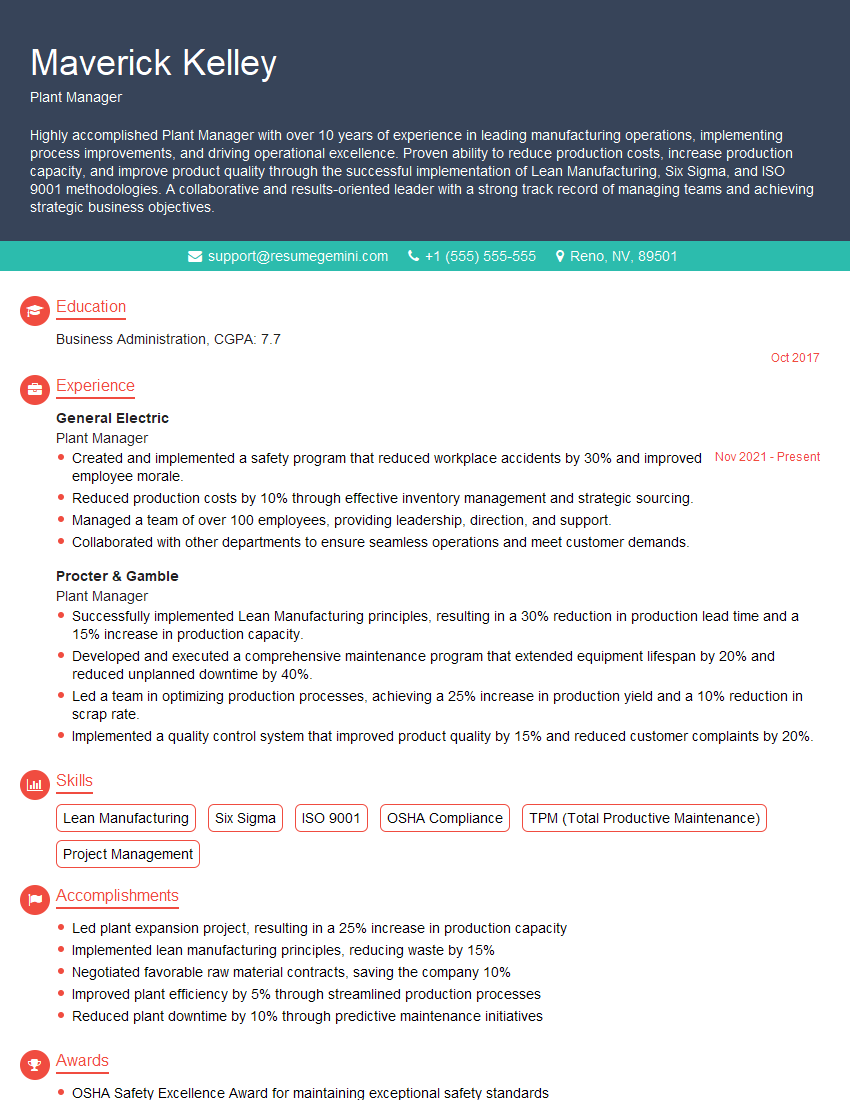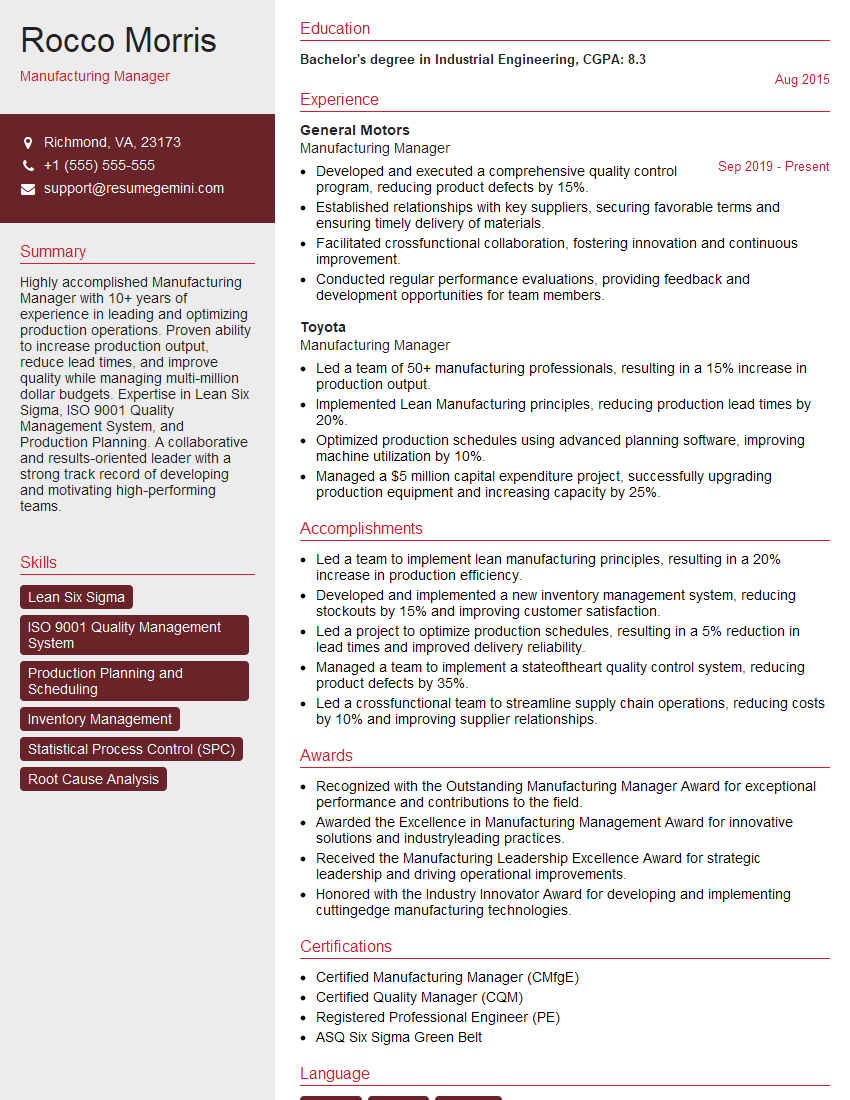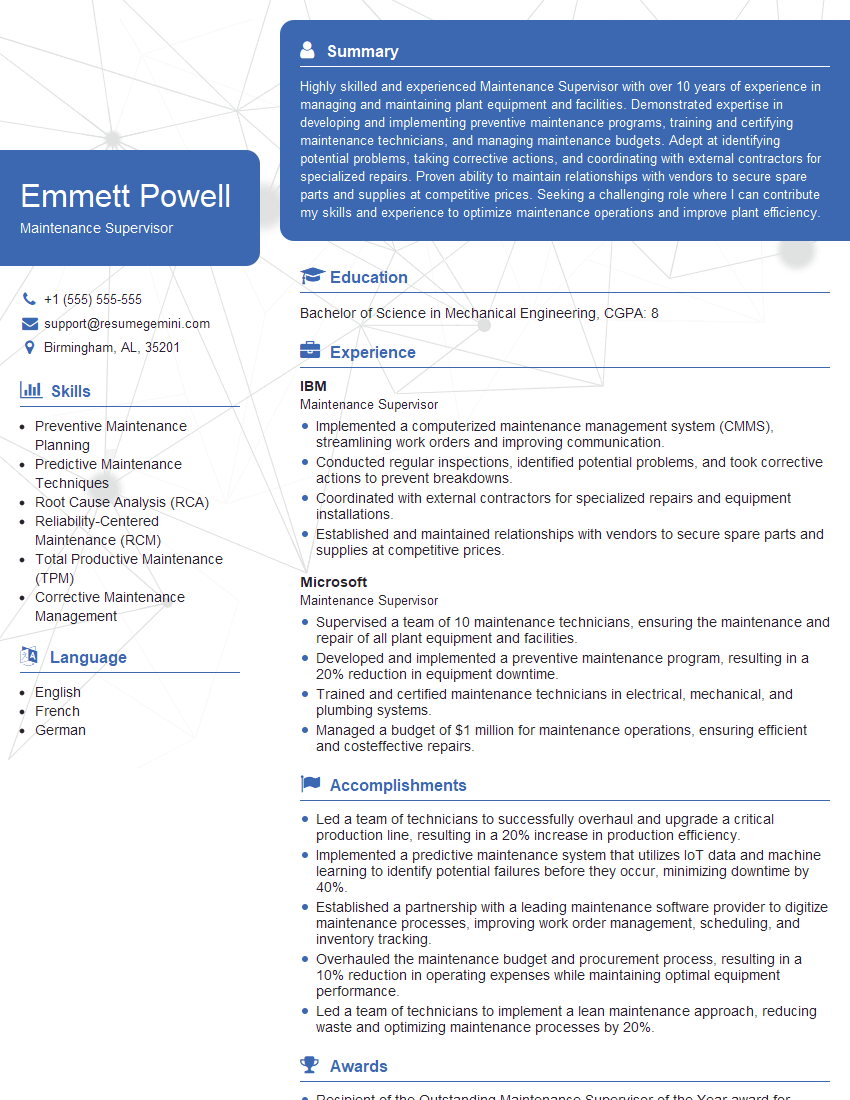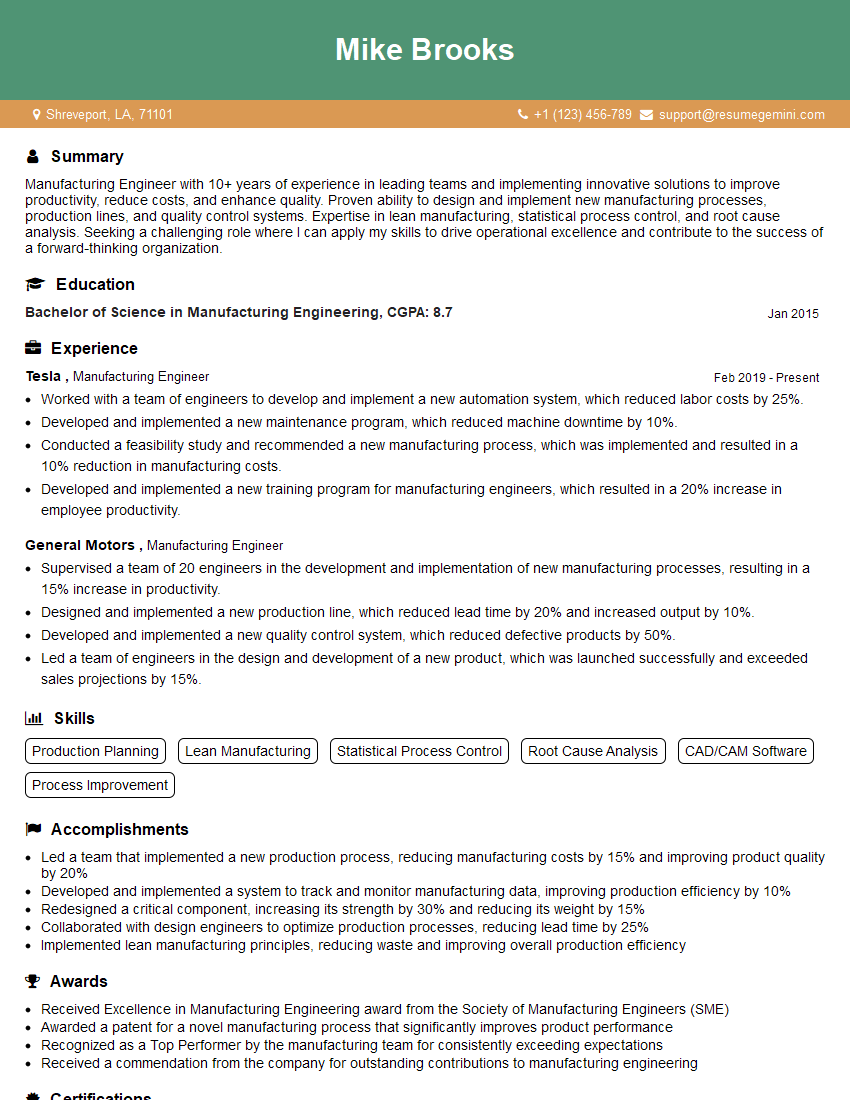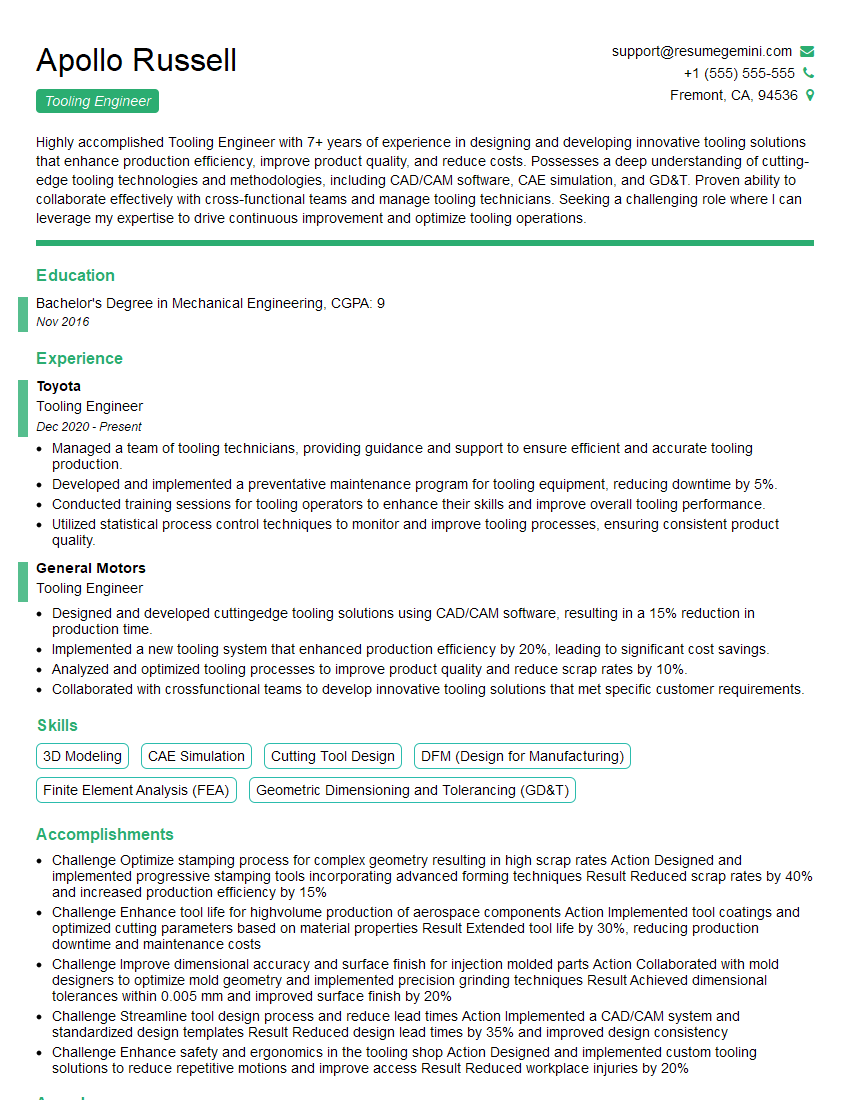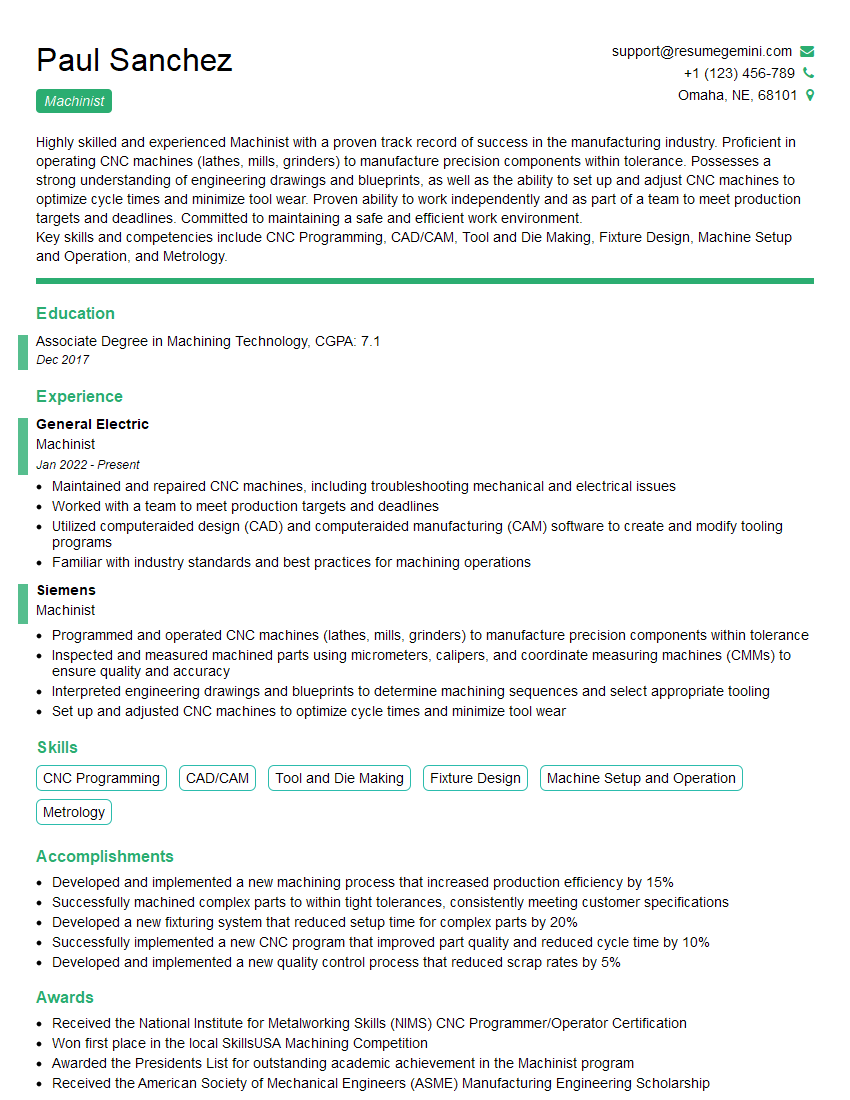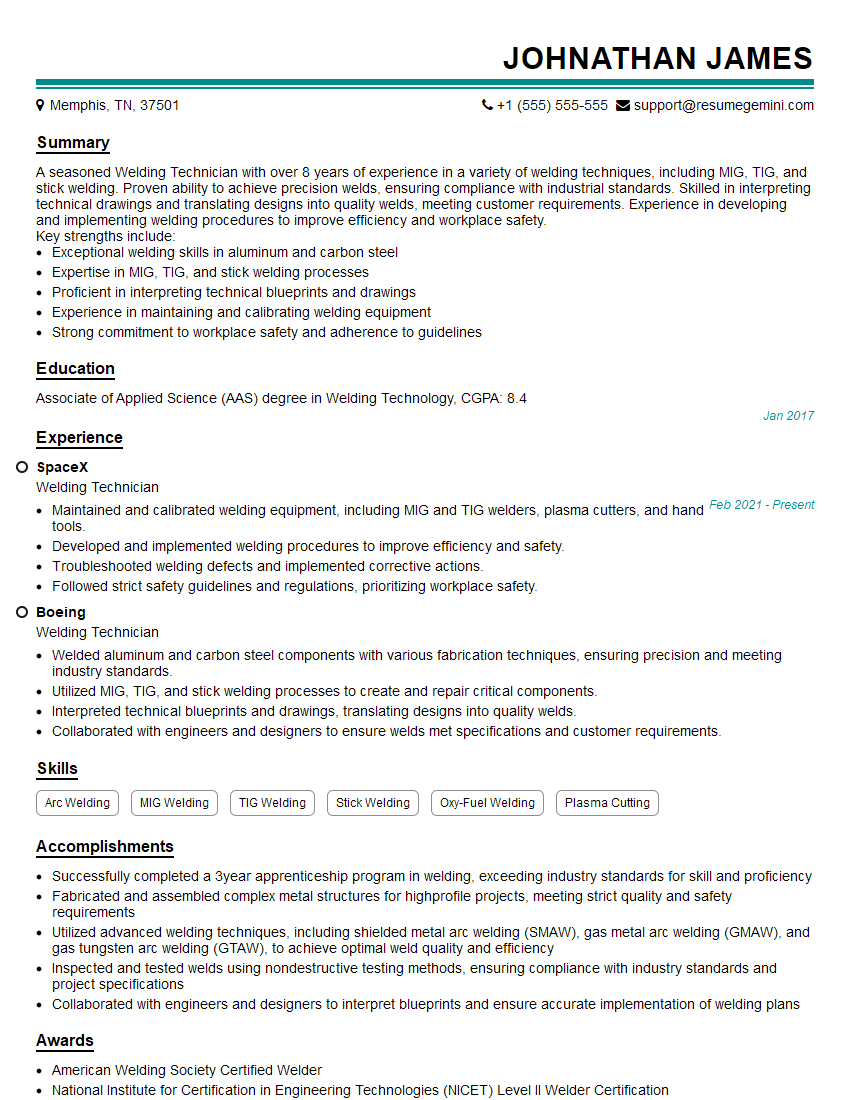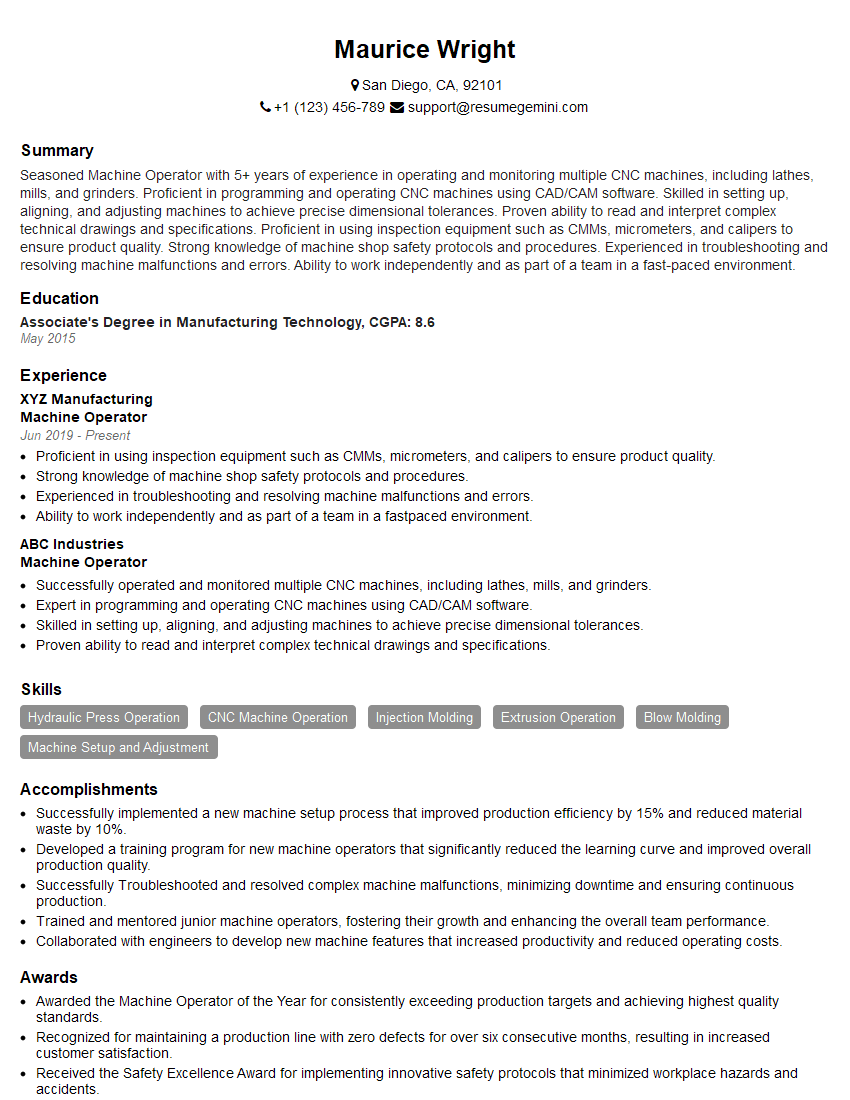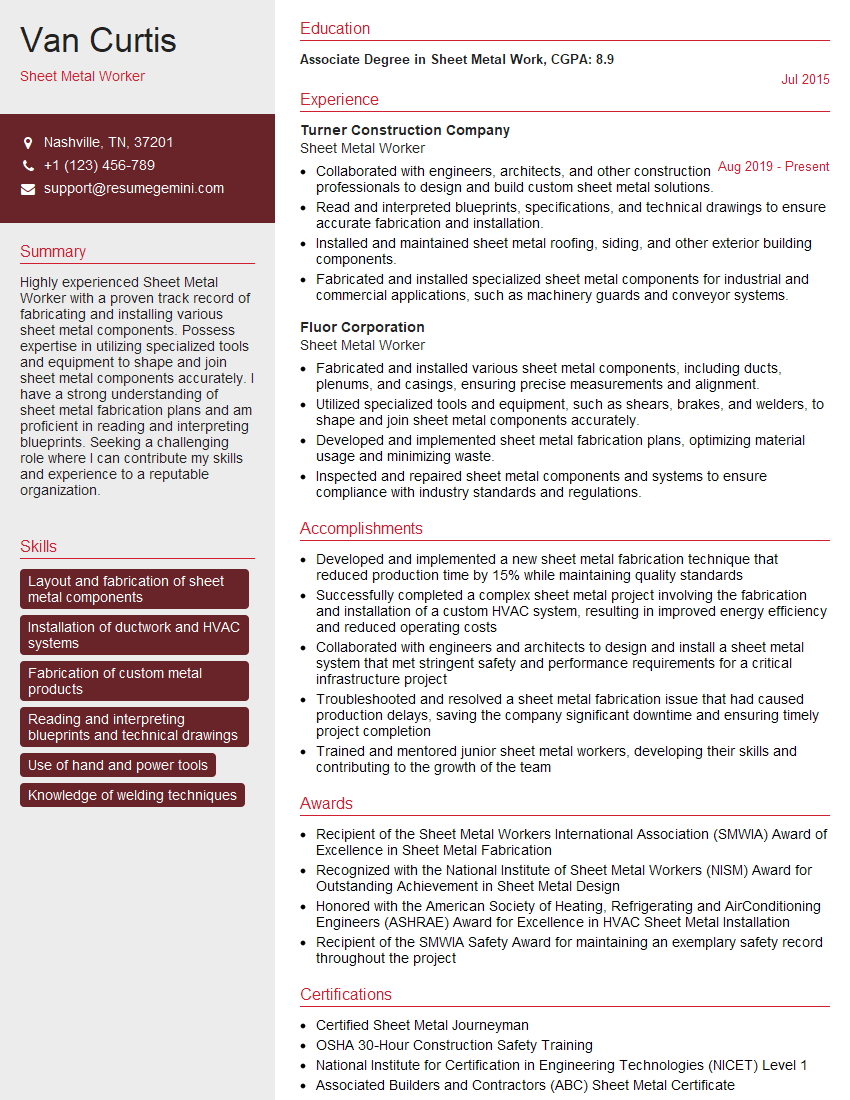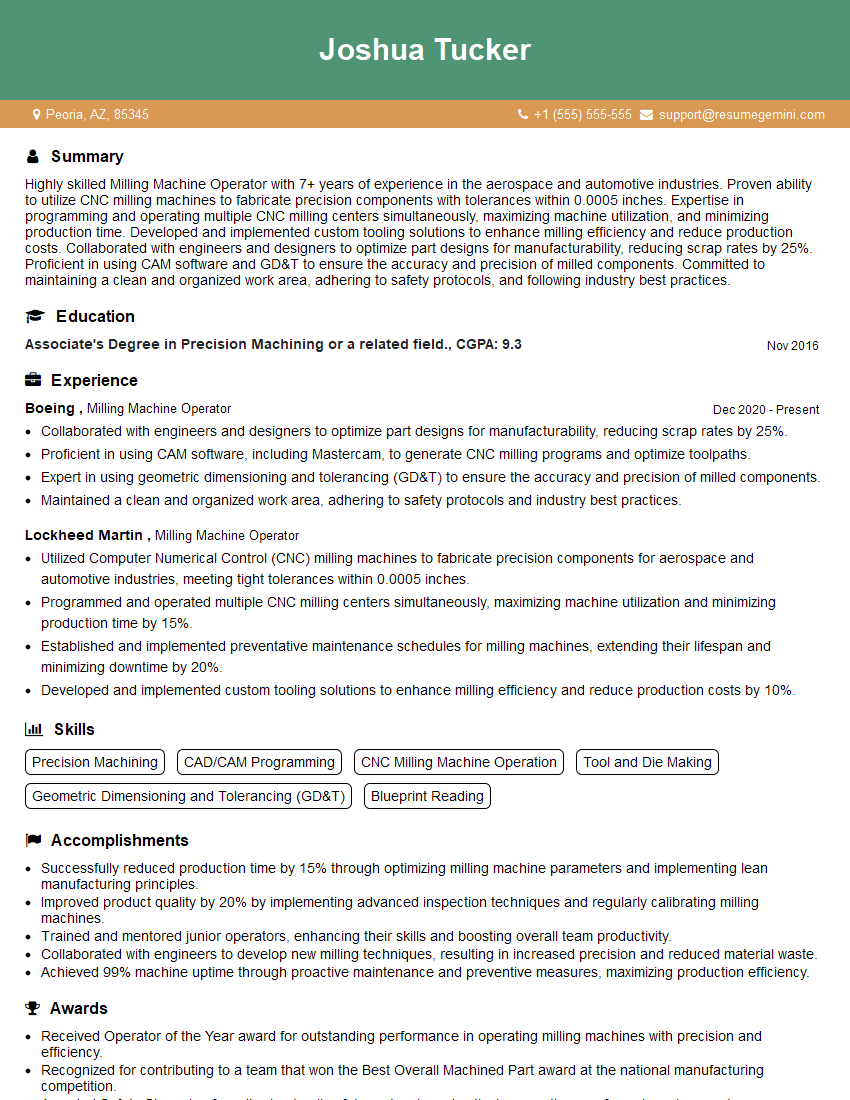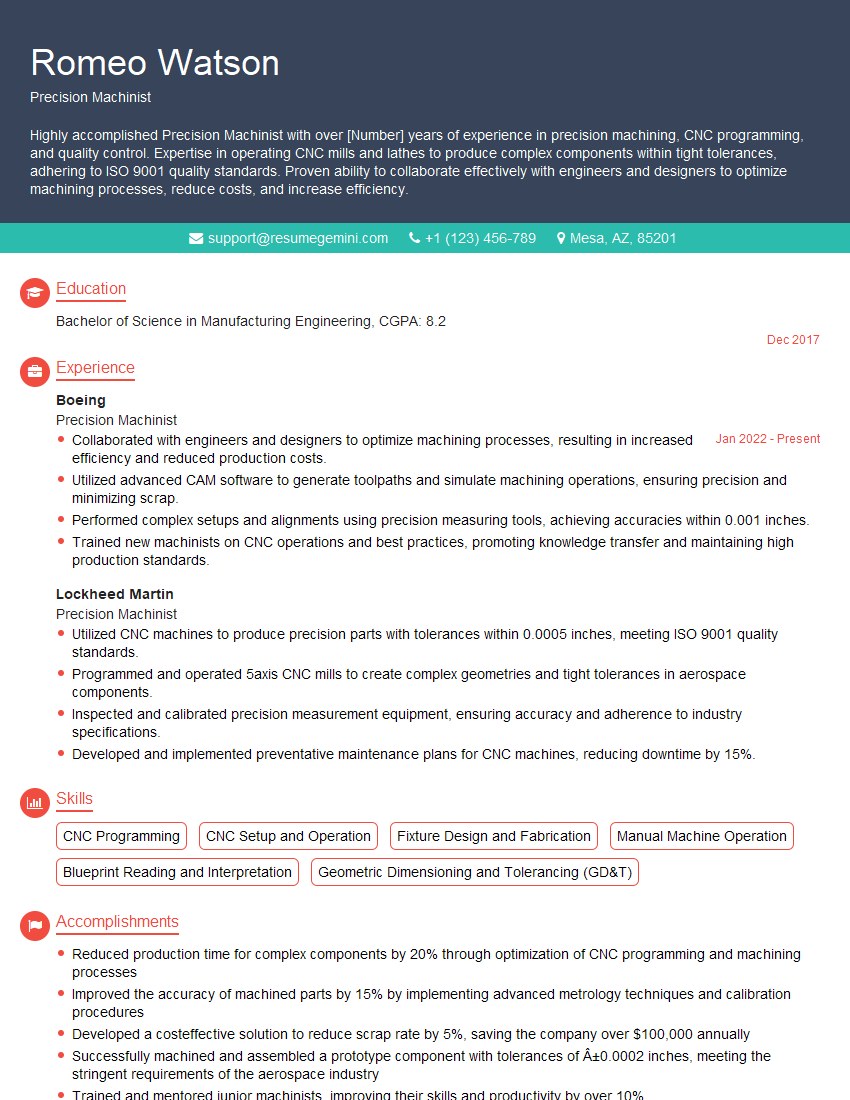Unlock your full potential by mastering the most common Machine Shop Skills interview questions. This blog offers a deep dive into the critical topics, ensuring you’re not only prepared to answer but to excel. With these insights, you’ll approach your interview with clarity and confidence.
Questions Asked in Machine Shop Skills Interview
Q 1. Explain the difference between a lathe and a milling machine.
Lathes and milling machines are both fundamental machine tools used for shaping metal, but they operate in fundamentally different ways. Think of it like this: a lathe is like a potter’s wheel, rotating the workpiece to create cylindrical shapes, while a milling machine is like a sculptor’s chisel, using rotating cutters to remove material from a stationary (or slowly moving) workpiece.
A lathe primarily performs turning operations. The workpiece is clamped and rotated, while cutting tools are fed against it to remove material, creating cylindrical, conical, or other rotational shapes. This is ideal for creating shafts, axles, and other parts with rotational symmetry.
A milling machine, conversely, uses rotating cutters to remove material from a stationary or slowly moving workpiece. This allows for the creation of a much wider variety of shapes, including complex curves, flat surfaces, and intricate details. It’s like a subtractive 3D printer using a rotating cutter instead of a laser or extruder. Milling is perfect for creating intricate parts, molds, and dies.
- Lathe: Primarily for rotational machining, creating cylindrical shapes.
- Milling Machine: For a wider range of shapes, including complex curves and flat surfaces, using various cutters.
Q 2. Describe your experience with various cutting tools (e.g., drills, taps, end mills).
My experience with cutting tools spans a wide range, encompassing various types and applications. I’m proficient in using drills for creating holes of specific diameters and depths, selecting the appropriate drill bit based on the material and desired hole size. This includes using different drill bit materials (high-speed steel, carbide) for varying applications.
Taps and dies are used for creating internal and external threads respectively, requiring careful selection based on thread pitch, diameter, and material. I understand the importance of proper lubrication to prevent tool breakage and ensure clean threads. I’ve worked extensively with end mills in milling operations, choosing the correct type (ball-nose, flat, bull-nose) depending on the desired surface finish and geometry. My experience also includes the use of specialized cutting tools like reamers for producing precise hole diameters and counterbores for creating countersunk holes. I am always meticulous in selecting and maintaining the sharpness of all tools to ensure optimal performance and prevent damage to the workpiece.
Q 3. How do you measure tolerances and ensure accuracy in your work?
Ensuring accuracy in machining relies heavily on precise measurement and tolerance control. I typically use a combination of instruments depending on the required precision. This starts with understanding the blueprint’s specifications.
- Vernier Calipers: For accurate linear measurements up to a few hundredths of a millimeter (thousandths of an inch).
- Micrometers: For even higher precision, measuring to thousandths of a millimeter (ten-thousandths of an inch).
- Dial Indicators: Used to measure surface flatness, runout, and other dimensional characteristics with high sensitivity.
- Coordinate Measuring Machines (CMMs): For highly complex parts requiring detailed 3D measurements.
Once measurements are taken, I compare them against the drawing tolerances. If discrepancies exceed the allowed limits, I investigate the root cause – could it be tool wear, improper setup, or a flaw in the machining process? Corrective actions are implemented to bring the part within tolerance. Accurate measuring instruments and a keen eye for detail are crucial to successful machining.
Q 4. What are your preferred methods for inspecting machined parts?
Inspection methods vary depending on the complexity and criticality of the machined part. For simple parts, visual inspection coupled with vernier calipers and micrometers suffices. More complex parts, however, demand a more rigorous approach.
- Visual Inspection: Checking for surface finish, burrs, and obvious defects.
- Dimensional Measurement: Using calipers, micrometers, and other precision instruments to verify dimensions against the blueprint.
- Surface Finish Inspection: Assessing surface roughness using a profilometer or by visual comparison to surface roughness standards.
- Non-destructive Testing (NDT): Methods such as dye penetrant inspection or ultrasonic testing can detect internal flaws or cracks.
- Coordinate Measuring Machines (CMMs): For complex parts and high precision, CMMs provide detailed 3D measurements.
Documentation of inspection results is essential. I always maintain detailed records of measurements and inspection procedures to ensure traceability and maintain quality control.
Q 5. Explain the concept of GD&T (Geometric Dimensioning and Tolerancing).
Geometric Dimensioning and Tolerancing (GD&T) is a standardized system for specifying tolerances and geometric control of features on engineering drawings. It goes beyond simple plus/minus tolerances by explicitly defining the allowed variations in size, form, orientation, location, and runout of features.
Instead of just specifying a diameter with a tolerance (e.g., 10mm ±0.1mm), GD&T uses symbols and zones to precisely define acceptable variations. For instance, a positional tolerance might specify that a hole must be located within a particular zone relative to other features. This allows for a more precise and unambiguous definition of part acceptance criteria.
Understanding GD&T is crucial for ensuring proper part functionality and interchangeability. It’s essential for complex assemblies where accurate mating of parts is critical.
In practice, it helps eliminate ambiguities and allows for manufacturing more efficient and functional parts by using a more universal and understandable specification system.
Q 6. Describe your experience with different types of machining processes (e.g., turning, milling, drilling).
My experience encompasses a wide range of machining processes, including turning, milling, and drilling. I’m comfortable with both manual and CNC machining operations.
- Turning: I’ve extensively used lathes for creating cylindrical and conical shapes, including facing, turning, boring, and threading operations. This includes working with various materials, from mild steel to aluminum and brass.
- Milling: My milling experience involves both manual and CNC milling machines, encompassing face milling, end milling, slot milling, and other operations to create complex shapes and surface finishes. I understand different types of cutters and their applications.
- Drilling: I am proficient in drilling various materials using different drill sizes and techniques, including spot-facing, countersinking, and counterboring.
I’m also familiar with other processes like grinding, tapping, and reaming.
Q 7. How do you troubleshoot common machining problems (e.g., chatter, burrs, dimensional inaccuracies)?
Troubleshooting machining problems requires systematic investigation. Let’s look at some common issues.
- Chatter: This is a vibration during machining that produces a poor surface finish. Causes include improper tool clamping, excessive cutting speed/feed, dull tooling, or insufficient rigidity in the machine setup. Solutions involve reducing cutting speed, increasing depth of cut in smaller increments, improving machine rigidity, and ensuring sharp tooling.
- Burrs: These are sharp edges left after machining. Causes include dull tools, improper cutting parameters, or insufficient clearance. Solutions include using sharp tools, adjusting cutting parameters, and employing deburring techniques.
- Dimensional Inaccuracies: Inaccuracies can stem from tool wear, improper machine setup, workpiece clamping issues, or thermal expansion. Solutions include regular tool inspection and replacement, proper machine calibration, precise workpiece clamping, and controlling the machining environment to minimize thermal effects.
My approach always begins with careful observation and measurement, followed by a systematic elimination of potential causes. I maintain detailed records of machining parameters to facilitate troubleshooting and continuous improvement.
Q 8. What is your experience with CNC programming (G-code, CAM software)?
My CNC programming experience spans over eight years, encompassing both G-code and various CAM software packages. I’m proficient in writing G-code manually, which allows me to deeply understand the machine’s movements and optimize programs for efficiency. However, I primarily utilize CAM software like Mastercam and Fusion 360 for more complex parts. These programs allow for the creation of toolpaths from 3D models, significantly reducing programming time and improving accuracy. For example, I recently used Fusion 360 to program a complex five-axis milling operation for a titanium component, resulting in a 20% reduction in machining time compared to a manually programmed approach. My expertise includes working with a wide range of CNC machines, including mills, lathes, and routers.
I’m familiar with various G-code commands, including those for rapid positioning (G00), linear interpolation (G01), circular interpolation (G02/G03), and tool changes (M06). I understand the importance of optimizing feed rates and spindle speeds to achieve the desired surface finish and prevent tool breakage. I’m also adept at troubleshooting G-code errors and making necessary adjustments to ensure smooth operation.
Q 9. Describe your experience with setting up and operating CNC machines.
Setting up and operating CNC machines is a meticulous process that demands precision and attention to detail. Before starting any operation, I thoroughly inspect the machine for any signs of damage or malfunction. I then securely mount the workpiece, ensuring proper clamping and alignment. Next, I verify the tooling – checking for wear, damage, and appropriate selection for the material. I meticulously load the CNC program, simulating the run to detect any potential collisions or errors. Only after a complete and thorough pre-operation check do I initiate the machining process. During the operation, I constantly monitor the machine’s performance, listening for unusual sounds and observing the cutting action. This allows for prompt detection and resolution of any issues.
For instance, I once noticed a slight vibration during a high-speed milling operation. Through careful observation and adjustment of the spindle speed and feed rate, I was able to eliminate the vibration and prevent potential tool damage or workpiece inaccuracy. Post-operation, I carefully remove the finished part, inspect it for accuracy and quality, and perform necessary cleaning and maintenance on the machine.
Q 10. How do you ensure the safety of yourself and others in the machine shop environment?
Safety is paramount in a machine shop environment. My approach to safety is proactive and multi-layered. I always wear appropriate personal protective equipment (PPE), including safety glasses, hearing protection, and appropriate clothing that prevents entanglement with moving parts. Before operating any machine, I conduct a thorough safety inspection, checking for loose parts, proper guarding, and ensuring the machine is functioning correctly. I strictly adhere to the shop’s safety protocols and guidelines.
Furthermore, I emphasize clear communication with fellow machinists. I always warn others before starting a potentially hazardous operation and maintain a clean and organized workspace to prevent accidents. I understand the importance of lock-out/tag-out procedures when performing maintenance or repairs. I believe that consistent vigilance and a culture of safety are crucial for preventing accidents. Regular safety training and continuous improvement are essential aspects of maintaining a safe workplace.
Q 11. Explain your experience with different types of materials (e.g., steel, aluminum, plastics).
My experience encompasses a wide range of materials, including various steels (mild steel, stainless steel, tool steel), aluminum alloys, plastics (ABS, acrylic, nylon), and occasionally, titanium and other exotic materials. I understand the unique properties of each material and how these properties impact machining parameters. For example, stainless steel requires specialized tooling and cutting fluids to prevent work hardening and ensure a smooth finish, while aluminum’s softness demands careful control to prevent tearing or chipping.
Working with plastics requires a different approach altogether, necessitating lower cutting speeds and specialized tooling to avoid melting or deformation. My experience with titanium, a very tough material, required me to learn advanced techniques like cryogenic cooling to manage heat build-up during machining. This diverse material experience has allowed me to adapt to various projects and challenges.
Q 12. How do you select the appropriate cutting tools and speeds for different materials?
Selecting the appropriate cutting tools and speeds depends heavily on the material being machined, the desired surface finish, and the machine’s capabilities. I utilize machinists’ handbooks and manufacturers’ recommendations to determine ideal cutting parameters. For example, when machining steel, I’d choose carbide tooling with appropriate geometry for the operation. The selection is guided by factors such as the hardness of the material, the depth of cut, and the required surface finish.
I would then consult charts or software to determine the appropriate spindle speed and feed rate based on the tool’s geometry, material properties, and desired surface finish. For softer materials like aluminum, I would use higher speeds and feed rates, while harder materials like steel would require lower speeds and feed rates to prevent tool breakage. Experience plays a crucial role here; I’ve learned to adjust these parameters based on the machine’s behavior and the resulting surface finish. Regular monitoring and adjustments are essential to maintain optimal cutting conditions and prevent tool wear or workpiece damage.
Q 13. What is your experience with using measuring instruments (e.g., calipers, micrometers, dial indicators)?
I’m proficient in using various measuring instruments, including calipers, micrometers, dial indicators, and height gauges. These tools are indispensable for ensuring accuracy and quality in machining. Calipers provide quick measurements, while micrometers offer greater precision for smaller parts. Dial indicators are crucial for checking alignment and surface flatness, detecting run-out, and measuring small variations in dimensions. I understand the limitations of each tool and use them appropriately based on the required accuracy and the type of measurement needed.
For instance, when inspecting a machined shaft for diameter, I would use a micrometer to get precise measurements to verify that the dimensions are within the tolerances specified in the engineering drawing. If checking the concentricity of a bore, I would use a dial indicator to measure the run-out and ensure it’s within acceptable limits. Accurate measurement is critical for ensuring quality control and meeting customer specifications.
Q 14. How do you interpret engineering drawings and blueprints?
Interpreting engineering drawings and blueprints is fundamental to my work. I am proficient in reading and understanding various types of drawings, including orthographic projections, isometric views, section views, and detailed part drawings. I understand the significance of dimensions, tolerances, surface finish specifications, and material notations. I can extract all the necessary information to accurately plan and execute the machining operations.
I frequently refer to geometric dimensioning and tolerancing (GD&T) symbols to understand the acceptable variations in dimensions and form. For example, I recently worked on a project with a tight tolerance requirement on a critical dimension. By accurately interpreting the GD&T symbol on the drawing, I ensured that the machined part met the required specifications. This capability is essential to produce parts that meet engineering requirements and ensure proper fit and function.
Q 15. Describe your experience with using different types of cutting fluids/coolants.
Cutting fluids, or coolants, are crucial in machining for several reasons: they lubricate the cutting tool, reducing friction and heat; they cool the workpiece and tool, preventing damage from excessive temperatures; and they help to wash away chips, improving surface finish and tool life. My experience encompasses a wide range of coolants, including:
Water-soluble coolants: These are commonly used and offer a good balance of lubrication and cooling. I’ve used many variations, adjusting the concentration based on the material being machined and the operation. For instance, a higher concentration might be used for tougher materials like titanium to improve lubrication and prevent tool wear.
Synthetic coolants: These are environmentally friendly and offer excellent performance, especially in situations requiring high-precision machining. I’ve found them particularly effective when working with delicate parts or achieving mirror-like finishes. Their longer shelf life also reduces waste.
Oil-based coolants: These are suitable for operations requiring heavy-duty lubrication, such as deep drilling or heavy milling. I have experience selecting the appropriate viscosity for the specific application, ensuring proper chip evacuation and preventing tool breakage.
Selecting the right coolant is a critical decision; the wrong choice can lead to poor surface finish, tool wear, and even catastrophic failure. My experience allows me to assess the specific machining parameters and material properties to select the optimal coolant for each job.
Career Expert Tips:
- Ace those interviews! Prepare effectively by reviewing the Top 50 Most Common Interview Questions on ResumeGemini.
- Navigate your job search with confidence! Explore a wide range of Career Tips on ResumeGemini. Learn about common challenges and recommendations to overcome them.
- Craft the perfect resume! Master the Art of Resume Writing with ResumeGemini’s guide. Showcase your unique qualifications and achievements effectively.
- Don’t miss out on holiday savings! Build your dream resume with ResumeGemini’s ATS optimized templates.
Q 16. What is your experience with maintaining and troubleshooting machine tools?
Maintaining and troubleshooting machine tools is paramount for efficient and safe operation. My experience includes preventative maintenance schedules, which are crucial for extending the life of the machine and preventing unexpected downtime. This includes regular lubrication, cleaning, and inspection of critical components.
Troubleshooting involves systematically identifying the root cause of a malfunction. For example, if a lathe is producing inaccurate cuts, I’d systematically check:
The machine’s alignment: This might involve using precision measuring tools to ensure the lathe bed is properly aligned and the chuck is true.
The tool condition: A worn or chipped tool will produce inaccurate cuts.
The control system: I would check the settings to ensure that they match the program and adjust them as needed.
The cutting parameters: Incorrect feed rates or spindle speeds can lead to inaccuracies or damage.
I’m also proficient in diagnosing hydraulic and pneumatic system issues, identifying problems with faulty sensors or actuators, and carrying out repairs in accordance with safety regulations.
Q 17. How familiar are you with different types of machine shop safety equipment (e.g., PPE, safety guards)?
Safety is my utmost priority in the machine shop. I’m intimately familiar with all aspects of safety equipment, including:
Personal Protective Equipment (PPE): This includes safety glasses, hearing protection, gloves appropriate for the material being handled (e.g., cut-resistant gloves), and appropriate clothing to avoid entanglement in machinery. I always ensure that all team members are correctly using PPE.
Machine guards: I understand the importance of properly functioning machine guards to prevent accidental contact with moving parts. I’ve been trained to inspect and maintain these guards, ensuring they meet safety standards.
Emergency shut-off procedures: I’m proficient in locating and using emergency stops on all machinery. I regularly practice emergency procedures with my team.
Lockout/Tagout procedures: Before any maintenance or repair on machinery, I consistently follow lockout/tagout procedures to prevent accidental start-ups.
Beyond the equipment, I also emphasize safe work practices, such as proper lifting techniques and awareness of potential hazards within the work environment.
Q 18. Explain your experience with using statistical process control (SPC) techniques.
Statistical Process Control (SPC) techniques are essential for maintaining consistent quality in machining. My experience involves utilizing control charts (like X-bar and R charts) to monitor key process parameters, such as surface roughness, dimensional accuracy, and tool wear.
For example, I’ve used X-bar and R charts to track the diameter of machined shafts. By plotting the average diameter (X-bar) and the range of diameters (R) over time, I can quickly identify any trends or shifts in the process that might indicate a problem. If a data point falls outside the control limits, it signals a potential issue needing investigation, which could range from needing to adjust a machine setting to requiring a tool change.
SPC allows for proactive identification of problems rather than reactive responses to defects, leading to significant improvements in quality, reduced scrap rates, and overall increased efficiency. I understand the importance of using SPC data to continuously improve processes and reduce variation.
Q 19. Describe your experience with working in a team environment.
I thrive in collaborative team environments. In previous roles, I’ve consistently worked with teams of machinists, engineers, and quality control personnel. I view teamwork as a critical element in achieving success. My approach emphasizes open communication, mutual respect, and shared responsibility.
For instance, during a complex project requiring tight tolerances, I worked closely with the engineers to understand design requirements and collaborate on optimal machining strategies. I also proactively shared my expertise with junior team members, providing guidance and mentoring to help develop their skills. I value the contributions of every team member and believe that diverse perspectives enhance overall project success.
Q 20. How do you handle pressure and tight deadlines in a manufacturing environment?
Manufacturing environments often involve pressure and tight deadlines. My approach is methodical and prioritizes efficient task management. I’ve developed strategies for effectively handling multiple tasks simultaneously while maintaining high-quality work.
When facing a tight deadline, my first step is to prioritize tasks based on their urgency and importance. I break down large tasks into smaller, manageable steps to improve focus and track progress more effectively. I also communicate proactively with my team and supervisors about any potential challenges and actively seek solutions.
While working efficiently is crucial, I never compromise safety or quality. I believe that a well-organized and proactive approach allows me to consistently meet deadlines while delivering high-quality results.
Q 21. How do you stay updated on the latest technologies and trends in machining?
Staying current with the latest technologies and trends in machining is essential for maintaining a competitive edge. I regularly utilize several methods to stay updated:
Professional organizations: I actively participate in professional organizations such as the Society of Manufacturing Engineers (SME), attending conferences and workshops to learn about the latest advancements in machining techniques and technologies.
Trade publications and journals: I regularly read industry publications and journals to remain informed about new developments in cutting tools, machine tools, and machining processes.
Online resources: I leverage online resources such as manufacturers’ websites and technical blogs to learn about the latest products and technologies.
Continuing education courses: I actively seek out and participate in continuing education courses to expand my knowledge and skills in specific areas. This allows me to improve my proficiency in new technologies and techniques.
This commitment to continuous learning ensures that I’m equipped with the latest knowledge and skills necessary to excel in this constantly evolving field.
Q 22. What are your strengths and weaknesses as a machinist?
My greatest strength as a machinist lies in my problem-solving abilities and my dedication to precision. I thrive under pressure, consistently delivering high-quality work even on tight deadlines. I’m proficient in a wide range of machining techniques, from basic milling and turning to more complex operations like CNC programming and EDM. I’m also a quick learner, readily adapting to new equipment and technologies. For example, when our shop upgraded to a new five-axis milling machine, I quickly mastered its operation and became a go-to resource for my colleagues.
A weakness I’m actively working on is delegation. I sometimes find it difficult to trust others with tasks, preferring to handle everything myself to ensure quality. However, I’m actively developing my leadership skills by focusing on clear communication and empowering my team members. I understand that effective delegation is essential for team efficiency and my own professional growth.
Q 23. What are your salary expectations?
My salary expectations are in line with the industry standard for a machinist with my experience and skill set. Considering my proficiency in various machining techniques, my experience with CNC programming and my proven ability to consistently deliver high-quality work, I am seeking a compensation package between [Insert Salary Range] annually. I am open to discussing this further based on the specifics of the role and the company’s benefits package.
Q 24. Why are you interested in this position?
I’m highly interested in this position because of [Company Name]’s reputation for innovation and its commitment to precision engineering. I’ve been consistently impressed by [mention a specific project or product], and the opportunity to contribute to such a forward-thinking organization is incredibly appealing. Furthermore, the chance to work with state-of-the-art equipment and a team of experienced professionals aligns perfectly with my career goals. I am particularly excited about the opportunity to [mention a specific aspect of the job description that excites you].
Q 25. Describe a time you had to solve a challenging machining problem.
During my time at [Previous Company Name], we received a rush order for a highly complex part with extremely tight tolerances. The initial CAD design had a critical flaw that would have resulted in a significant machining error. I noticed the flaw during the setup process. Instead of proceeding, I carefully analyzed the design, identifying the root cause of the problem – an inaccurate calculation in the initial CAD model. I then collaborated with the design engineer, proposing a solution involving a slight modification to the part’s geometry. This required a shift in our machining strategy, utilizing a different tooling setup and programming adjustments. The modified approach proved successful, and we delivered the parts on time and to the client’s exacting specifications. This experience reinforced the importance of thoroughness and collaboration in problem-solving.
Q 26. How do you handle disagreements with coworkers or supervisors?
Disagreements are inevitable in any collaborative environment. My approach centers on open and respectful communication. I believe in actively listening to understand the other person’s perspective before stating my own. I always strive to find common ground and a solution that benefits the entire team. For example, in a previous situation, a coworker and I disagreed on the best approach to a particular machining task. Instead of arguing, we discussed our respective methods, highlighting the pros and cons of each. Ultimately, we combined aspects of both approaches to create an even better solution, demonstrating the power of collaborative problem-solving. If a resolution can’t be reached at the team level, I’m comfortable escalating the issue to my supervisor, but always with the aim of finding a fair and constructive outcome.
Q 27. What are your long-term career goals?
My long-term career goals involve becoming a highly skilled and respected leader within the machining industry. I aspire to expand my expertise in advanced machining techniques, such as additive manufacturing and automation. I also see myself mentoring younger machinists and contributing to the advancement of best practices within the field. I’m interested in taking on more responsibility, potentially leading a team or even managing a machining department. Ultimately, I aim to contribute significantly to innovation and efficiency within the manufacturing sector.
Key Topics to Learn for Machine Shop Skills Interview
- Safety Procedures and Regulations: Understanding and applying safety protocols in a machine shop environment, including proper use of PPE and emergency procedures. Practical application involves demonstrating knowledge of lockout/tagout procedures and hazard identification.
- Blueprint Reading and Interpretation: Accurately interpreting technical drawings, including dimensions, tolerances, and specifications. Practical application involves explaining how to translate blueprint information into machining operations.
- Machining Processes: Comprehensive knowledge of various machining processes such as milling, turning, drilling, grinding, and their respective applications. Practical application involves describing the selection criteria for different machining processes based on material and desired outcome.
- Machine Operation and Maintenance: Proficiency in operating various machine tools (lathes, mills, grinders, etc.) and performing routine maintenance tasks to ensure optimal performance. Practical application involves detailing preventative maintenance schedules and troubleshooting common machine malfunctions.
- Measurement and Quality Control: Utilizing precision measuring instruments (calipers, micrometers, gauges) to ensure accuracy and quality control throughout the machining process. Practical application involves explaining tolerance analysis and methods for detecting and correcting machining errors.
- Material Properties and Selection: Understanding the properties of different materials (metals, plastics, composites) and selecting appropriate materials for specific applications. Practical application involves discussing the impact of material choice on machining processes and final product performance.
- Computer Numerical Control (CNC) Machining: Familiarity with CNC programming and operation, including G-code and CAM software. Practical application involves explaining the advantages of CNC machining and its role in modern manufacturing.
- Problem-Solving and Troubleshooting: Ability to identify and resolve problems related to machine operation, tooling, and material processing. Practical application involves describing a past experience where you successfully solved a machining-related problem.
Next Steps
Mastering Machine Shop Skills opens doors to exciting and rewarding careers in manufacturing, engineering, and related fields. To maximize your job prospects, creating a strong, ATS-friendly resume is crucial. ResumeGemini is a trusted resource that can help you build a professional resume that showcases your skills and experience effectively. Examples of resumes tailored to Machine Shop Skills are available, providing you with valuable templates and guidance to present yourself in the best possible light. Invest the time to create a compelling resume – it’s your first impression on potential employers.
Explore more articles
Users Rating of Our Blogs
Share Your Experience
We value your feedback! Please rate our content and share your thoughts (optional).
What Readers Say About Our Blog
There are no reviews yet. Be the first one to write one.
